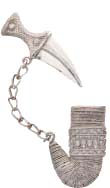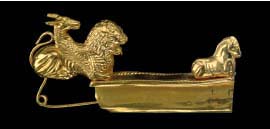Read My Pins (11 page)
Authors: Madeleine Albright

Solidarity, designer unknown.

Heart-health red dress, National Institutes of Health;
In our own day, security experts rely on coded pins to identify people who are cleared to enter a particular area while excluding those who are not. Members of Congress are given pins so that they might avoid being stopped by guards while en route to their offices or the legislative floor. Clubs and lodges typically use badges (along with secret handshakes) to enable fellow members to recognize a common bond. Voters display pins to demonstrate allegiance to political candidates or causes. My own loyalties could be seen in a pin labeled “ESM,” identifying me as an early backer of U.S. Senator Edmund S. Muskie; a “Solidarity” clip that, in 1981, I was given by anti-Communist activists in Poland; a pink ribbon for the race to cure breast cancer; a red dress for women’s heart health; and a saxophone pin evoking our one and only sax-playing chief executive, Bill Clinton.

Susan G. Komen for the Cure breast cancer ribbon.
Finally, our armed forces also use pins—in the form of ribbons and medals—to convey messages about accomplishments, stature, and rank. I was reminded of this during my time as UN ambassador.

Harry Truman was president when my family arrived in America. Since then I have participated in many political campaigns and worn my share of buttons, including these featuring Truman and five other presidents.

U.S. DEPARTMENT OF DEFENSE
With General John Shalikashvili, who succeeded Colin Powell as chairman of the Joint Chiefs of Staff. In the background are Janet Langhart Cohen and Secretary of Defense Bill Cohen. It was Janet who designed the eagle and dove pin on the opposite page, celebrating
NATO
’s fiftieth anniversary.
In 1993, the chairman of the Joint Chiefs of Staff was General Colin Powell. We were both members of the Clinton national security team and sat across from each other at the long rectangular table in the White House Situation Room. Although we saw eye to eye on many controversies, we did not agree on whether the United States and NATO should intervene to stop ethnic cleansing in the former Yugoslav Republic of Bosnia. I thought we should act and listed the reasons why; General Powell expressed doubts and listed the reasons why not. The dilemma for me was that although I had my patriotic pins, he had a chest full of well-earned medals. He was fresh from victory in the first Gulf War and cut a dashing figure in his uniform; I was fresh from my classrooms at Georgetown and, even in my best suit, resembled something of a dumpling (this was before I began working out).
As a civilian and a woman, I did not feel comfortable challenging the wisdom of such a true American hero, but I also knew that I had not been given a chair in the Situation Room to imitate a potted plant. I took my own advice and interrupted, arguing that the United States had an urgent interest in halting the slaughter of innocent people in the Balkans. Using a pointer and slides, Powell made clear his own expectation that the potential costs of such an effort would far outweigh the benefits. For months, we were at a stalemate; the administration did nothing, and, as the killing continued, I grew frustrated and at one meeting finally let loose.

Partners in Peace, Janet Langhart Cohen/Ann Hand.

DIRCK HALSTEAD/
TIME
Some of my more deadly pins.
Jambiya dagger, Yemen;

DIRCK HALSTEAD/
TIME
rocket-propelled grenade launcher (RPG), Pakistan.

DIRCK HALSTEAD/
TIME
On the cover of
Time
magazine, May 17, 1999.
“Colin,” I asked, “what are you saving this superb military for, if we can’t use it?” In his autobiography, Powell wrote that my question almost gave him an aneurysm and that he was compelled to explain to me—patiently—the appropriate role of the U.S. armed forces. In retrospect, I am willing to concede that the general was right to be cautious, right to ask questions, right to consider alternatives, and right to worry about the facile assumptions of civilian leaders. However, I was right about Bosnia, where NATO did eventually intervene and as a result saved thousands of lives.
Although I love pins, they have in common with necklaces and bracelets one complication: the clasp. Thus it has ever been. The earliest pins were less ornamental than functional. Primitive hunter-gatherers used thorns or sharp pieces of flint to keep their clothes from falling off while they ran around in pursuit of lunch. As civilization progressed from the Stone Age to the Bronze and Iron eras, pieces of metal began to serve the same essential purpose. From there, it was only a short step to the use of rare ores and gemstones that combined the fastening with the alluring. Royal burial sites in Ur, home city of the patriarch Abraham, included gold and silver pins—some topped by lapis lazuli beads—that would have been used to secure robes at the shoulder.

THE TRUSTEES OF THE BRITISH MUSEUM
Knot of Hercules, Ilias Lalaounis.

